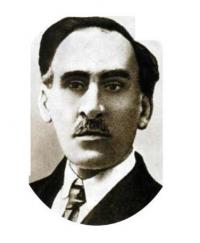Alexander Vasilyevich Fomin
Alexander Vasilyevich Fomin ( Russian Александр Васильевич Фомин ; Ukrainian Олександр Васильович Фомін ; born May 2, jul. / 14. May 1867 greg. In Jermolowzy, Saratov province , Russian Empire ; † 16th October 1935 in Kiev , Ukrainian SSR ) was a Russian - Soviet botanist , zoologist and microbiologist specializing in the study of the flora of the Caucasus , especially ferns . He directed the first botanical garden in Kiev, which in 1936 was named the Kiev Botanical Garden "AW Fomin" in his honor . Its official botanical author abbreviation is " Fomin ".
His wife was the daughter of Gustav Radde , Olga Gustawowna Radde (1873–1963), a granddaughter of Johann Friedrich von Brandt .
biography
In 1893 he graduated from Moscow University . From 1896 Fomin worked as a research assistant at the Jurjew University of Tartu . In the years 1888–1890 he undertook, together with Nikolai Iwanowitsch Kuznetsov and Nikolai Adolfowitsch Busch , on behalf of the Imperial Russian Geographical Society, several plant-geographic expeditions to the Caucasus (see expedition map for routes).
In 1902 Fomin got a job as a botanist in Tbilisi, where he had a major say in the layout of the botanical garden . The management of the then Vladimir University of Kiev (since 1936 National Taras Shevchenko University of Kiev ) appointed him to Kiev in 1914. In the same year he was also given the management of the botanical garden, which had already opened at the end of the 19th century. Until 1927 he was a professor at Kiev University, then he retired. After his death, the university management paid tribute to Fomin's services to the development of botany and to the botanical garden attached to the university by giving this garden his name.
Since 1921 Fomin was a member of the Ukrainian Academy of Sciences .
Act

Fomin is considered to be the founder or source of ideas for the research facilities Botanical Garden in Tbilisi and Herbarium KW in Kiev.
In 2009 the Institute of Botany and the Institute Herbarium began to publish a journal named after Alexander Fomin for the first time: "Fominia".
Publications
- Fomin: Заметки и наблюдения относительно некоторых растений Кавказа (German: "Notes and observations on some plants of the Caucasus.") . Proceedings of the Tbilisi Botanical Garden. Ed .: Printed by KP Kozlowski. VI, 3rd edition. Tbilisi 1904, p. 33 ff . (Ukrainian, archive.org [PDF; 31.9 MB ; accessed on September 14, 2012]).
literature
- E. Bordzilowskij: In memory of Aleksandr Wassiljewitsch Fomin (1869-1935). / Soviet botanist . 1936, number 1. (with a bibliography of Fomin's works).
- Збірник праць, присвячений памяті академика О. В. Фоміна (collection of articles commemorating Alexander Fomin); Kiev, 1938.
- SJ Kondratjuk, MW Shevera, WM Wіrchenko: Академік О.В. Фомін - фундатор наукової школи, ботанічних установ та періодичних видань. Мохоподібні України. Ексиката. Fominia, No. 1 , 2009, ISBN 978-966-02-5455-8 (Ukrainian, online [PDF; 868 kB ; accessed on September 14, 2012]).
- Article Alexander Wassiljewitsch Fomin in the Great Soviet Encyclopedia (BSE) , 3rd edition 1969–1978 (Russian)
- 16 жовтня 1935 року помер ботанік, директор Ботанічного саду Київського університету Фомін Олеквандр. Ukraїnі Pravoslavіє (Ukrainian), accessed September 15, 2012 (Ukrainian).
- Acad Botanical Garden. A. Fomin; Historical background. Retrieved September 15, 2012 (Russian).
Web links
- Author entry and list of the described plant names for Alexander Wassiljewitsch Fomin at the IPNI
- Фомин, Александр Васильевич (Fomin, Alexander Vasilyevich) at botany.taxon.pro (Russian).
Individual evidence
- ^ Walter Nestmeier: Two botanists: Prof. AW Fomin, his wife Prof. Olga Radde-Fomin and the reference to feet. Historical Association Säuling, annual publication 08, 2018, Miroslav W. Schewera (Kiev / Ukraine): The forgotten Ukrainian botanist Olga Gustavivna Radde-Fomina (on her 140th birthday). German translation from: Ukrainisches Botanisches Journal, Volume 73, Issue 4, 2016, pp. 409–414, History of Science. Published on September 19, 2016, (PDF) .
- ↑ NIKusnezow: O б o т a ник o- г eo г pa фич ec кихъ из c лъд o в a н i яхъ Ka вк a з a, co в ep ш e нныхъ п o п op уч e н i ю Имп epa т opc к a в o Ру cc к a в o Г eo г pa фич ec к a в o O бщ ec т ba. (German: "Plant Geographic Studies of the Caucasus, on behalf of the Imperial Russian Geographical Society") . Description of the travel routes between 1888 and 1900. Ed .: Proceedings of the Imperial Russian Geographical Society, St. Petersburg. 2nd Edition. tape XXXVIII , 1902, pp. 206–227 ( Online [PDF; 2.1 MB ; accessed on September 14, 2012]).
- ^ Website of the Botanical Institute of the National Academy of Sciences of Ukraine. accessed on December 14, 2015.
| personal data | |
|---|---|
| SURNAME | Fomin, Alexander Wassiljewitsch |
| ALTERNATIVE NAMES | Фомин, Александр Васильевич (Russian spelling) |
| BRIEF DESCRIPTION | Russian-Soviet botanist, zoologist and microbiologist |
| DATE OF BIRTH | May 14, 1867 |
| PLACE OF BIRTH | Jermolowzy, Saratov Governorate , Russian Empire |
| DATE OF DEATH | October 16, 1935 |
| Place of death | Kiev , Ukrainian SSR |

